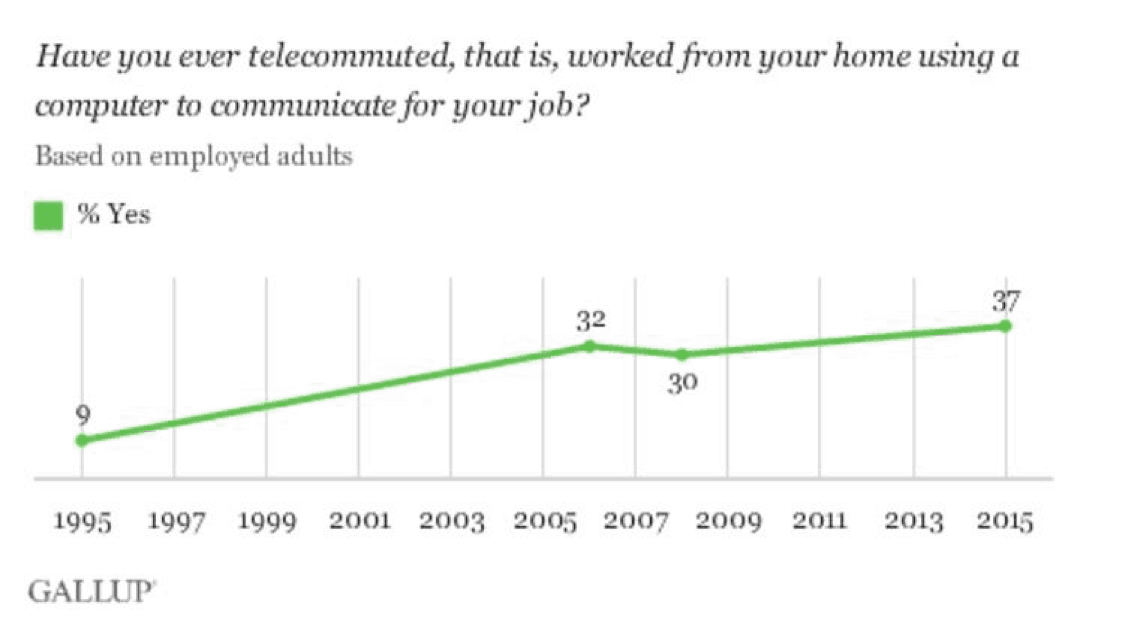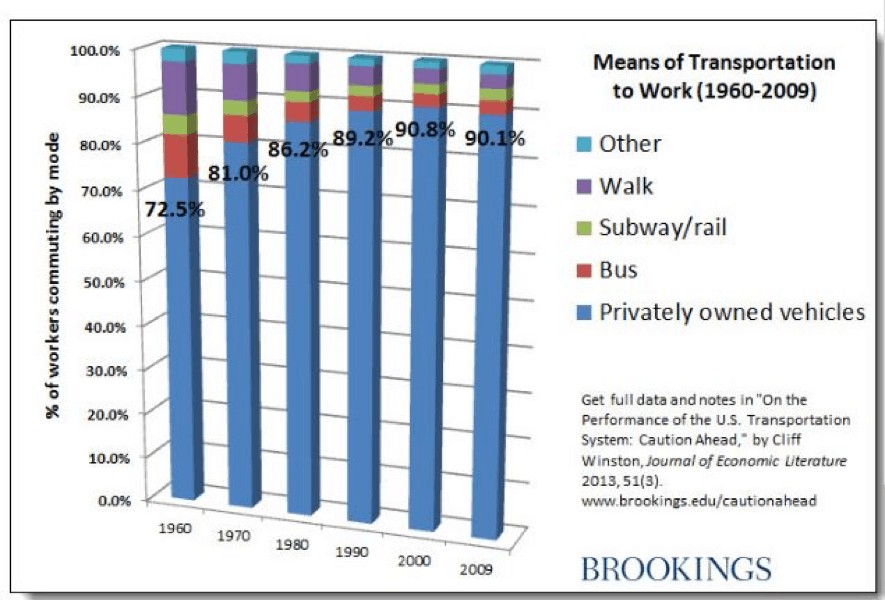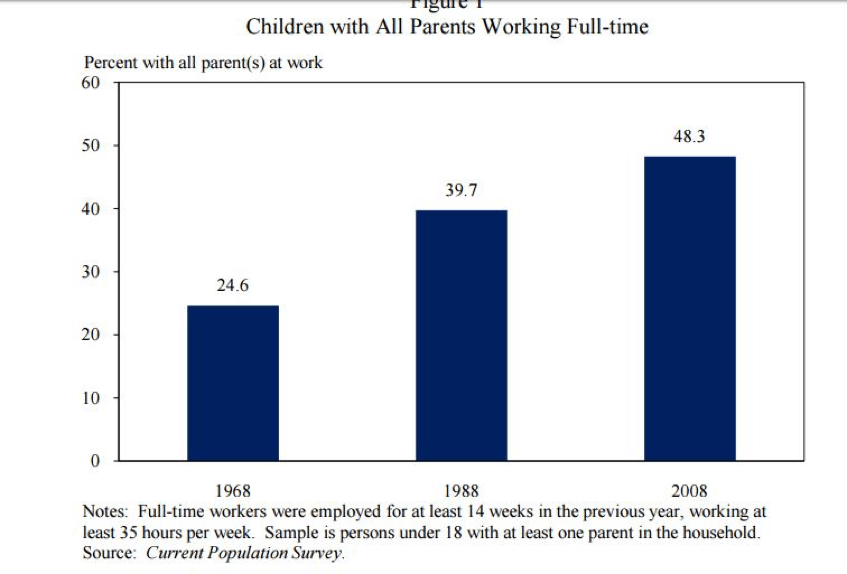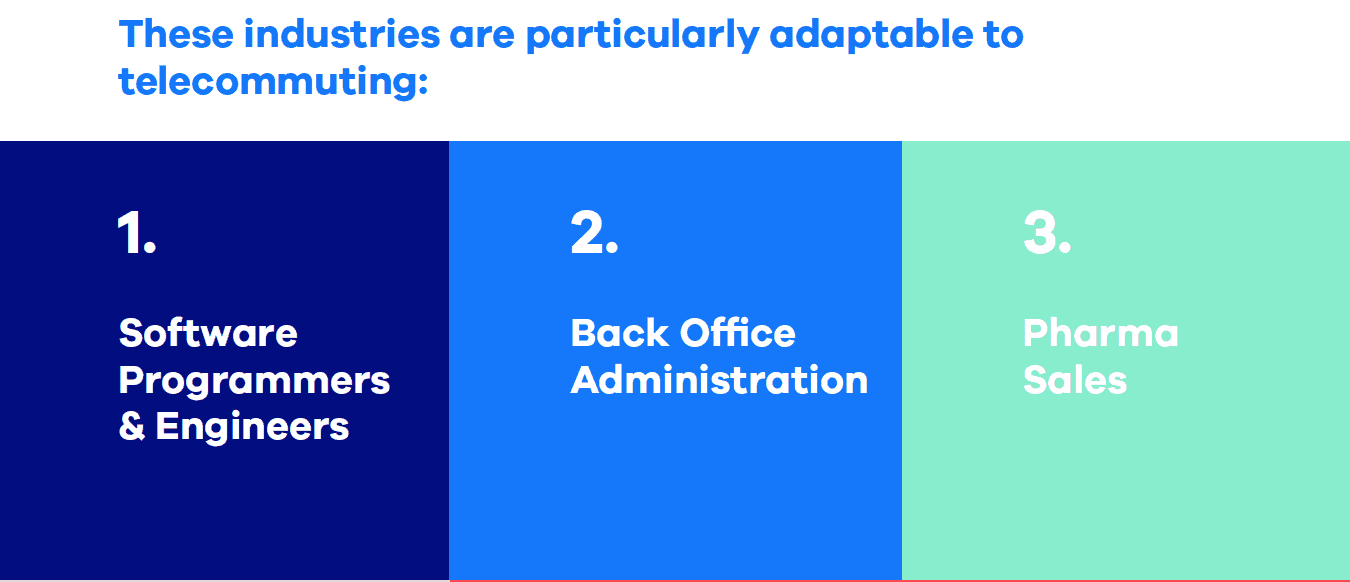Your Complete Guide to the Remote Workforce

Telecommuting and the remote workforce has been growing since technology has begun to transform our lives. Along with transformations in technology, we’ve seen an adoption of the remote workforce by mainstream employers with a mountain of stats and information that backup the support for telecommuting. Employee satisfaction, and increased productivity are credited as the largest benefits, the work from home crowd is definitely shifting how we think about going to work.
Download the Full Color PDF Guide Here
That could explain why a greater number of U.S. workers now work from home than at any time in history (excluding, of course, any point in time before the Industrial Revolution, when everyone worked from home). Take a look at the growing trend, as shown by a recent Gallup poll:

Around the globe, telecommuting is even more popular. PGI’s Global Telework Survey confirms what we all suspect: a whoppingly high number of global workers (79 percent of knowledge workers, in fact) are telecommuters. What’s more, 60 percent of knowledge workers would drop their current gig in a flash if they could work from home full time.
Telecommuting is on the rise, no matter who’s reporting the stats. Pick your preferred authority: every reputable source from the Bureau of Labor Statistics to the New York Times is reporting on this phenomenon.
What’s the Attraction of Working From Home?
For employees, the reasons for preferring to work from home boil down to a few simple benefits (simple yet overwhelmingly powerful, that is).
1. No More Road Rage, Crowded Subways, Traffic Jams…
The most obvious advantage of telecommuting is no more horrible commute to work. For the more than 90 percent of Americans who drive to work, telecommuting represents a total change in lifestyle.
A Huge Percentage of Cars Would Disappear From Roads if Telecommuting Really Took Off
2. It’s Cheaper
According to the American Automobile Association’s fascinating annual Your Driving Costs report, the opportunity cost of commuting has decreased but it’s still shockingly high.
It costs a lot to commute to work, but that’s only one of the reasons people love telecommuting.
3. It Leaves More Time for Life Outside of Work
When we’re not spending an average of 25.4 minutes each way on our daily commute to work, there’s suddenly a whole lot more time in life for… life. You’ve heard of the life-work balance? Telecommuting is how you achieve that.
4. More Time with Friends and Family
We all have friends at work, and enjoy the social gathering, but friends and family are high priority for most anyone.
More than half of all American families have both parents working. Reducing the commute, and increasing the time at home saves time, money, and energy and allows more time at home with the family.
There are endless socio-political reasons that having a parent at home during childhood is beneficial. It’s good for families and it’s good for society. A 1998 study found that workers with children rated the stress reduction of telecommuting higher than those without children. In other words, telecommuting means a lot to parents, as well as to their children of course.
Finally, there are a few economic reasons, too, namely that daycare expenses are chipping away at families’ incomes like a hungry wolf might “chip away” at a shank of meat.
5. You Can Take Care of Things While You Work
Got a leaky faucet? A sick dog? A bad cold? Traditional workers would have to choose whether to take care of life’s little curve balls or trudge in to work. Telecommuters can do both (without the trudging, of course).
6. Your Life is Less Stressful
Unless your home life is riddled with stress points and your job is your only salvation for sanity, working from home will reduce your stress levels significantly. Results from studies vary, but some report as high as 82% of remote workers say their stress levels are reduced because they don’t commute to work.
What’s in it For Employers, Though?
Contrary to popular belief, telecommuting has been linked to an actual increase in productivity.
Stanford University Professor of Economics Nicholas Bloom conducted a huge telecommuting study in 2011 and found three very important advantages for employers who chose a remote workforce. We’ll show you even more after telling you about his big three.
1. Save Space and Overhead
With fewer workers, you have lower overhead costs (slash your pencil budget!). Save on supplies, utilities, and even rent.
Aetna has anywhere from 14,500 to 35,000 remote workers, allowing them to forgo 2.7 million square feet of office space. The savings? An impressive $78 million! American Express did the same and their savings topped $15 million annually.
Cisco started allowing telecommuting and as a result saved $277 million a year. And think of the money you’ll save in transportation reimbursement.
Plus, since remote employees tend to be more productive and stay longer at their jobs (see the next two reasons), you will save money due to those factors, too. Telework Coalition estimates that the average business saves around $20,000 per year for each individual full-time worker!
2. Increase Employee Retention
Bloom found that telecommuters were happier with their jobs, and therefore less likely to quit. For employers, that’s less turnover, which means less time spent training new hires. Cha-ching.
A National Institutes of Health study found that telecommuters had higher job satisfaction, better performance, less stress, and as a result, fewer quit their jobs. In fact, some benefits of telecommuting increased as time spent working from home increased. These included such factors as better performance evaluations.
Relationships with co-workers, however, did not improve when telecommuting rates went higher. Nevertheless, the overall effect of allowing workers to work from home seems to be, in study after study, increased job satisfaction and less turnover.
3. Increase Productivity
Back to Professor Bloom’s study, which was actually conducted on his own company, a customer service operation in Shanghai. Telecommuters (workers who worked four days from home and one day in the office) were able to handle 15 percent more calls. Overall, they were four percent more productive than their colleagues back in the office.
Incredibly, the telecommuters also worked 11 percent more hours than their colleagues who slogged into the call center every morning.
Why might this be? Bloom’s telecommuters:
- took fewer sick days
- exercised more
- smoked less
- took fewer breaks
- weren’t ever late because of commuting issues
- were less likely to quit their jobs
Here’s another case in point: Automattic. They are 100% “distributed”, which is an insider’s term for a company with a remote workforce. They run WordPress, one the most-visited websites in the world. Absolutely everyone who works for Automattic does so from home/cafe/wherever… anyplace but an Automattic office, if there even is such a thing. They’re hugely successful, and here’s what their workforce looks like:
What a Remote Workforce Looks Like
4. Philanthropic Reasons for Telecommuting
If you care enough about the world outside your business to make changes accordingly, then telecommuting makes sense for several philanthropic reasons, too.
- Telecommuting is green. Less commuting means less car driving, which means less pollution.
- Telecommuting opens up opportunities for rural workers. Hey, you don’t have to move to New York any more to get the best jobs (or L.A. or San Francisco or Chicago…)
- Telecommuting opens up opportunities for those with disabilities. For anyone with mobility challenges, being part of a remote workforce is a godsend.
In a press release published in 2009, Cisco reported that their teleworkers prevented over 47,000 metric tons of greenhouse gas from entering the environment. For the workers, that translated into over $10 million saved annually in fuel costs.
So, now you see how having allowances for a remote workforce becomes an act of corporate social responsibility.
5. You Can Hire the Best, Even if They Don’t Live Nearby
Here is another reason for employers to love a remote workforce: you can now hire the best employee for the job. You may now expand your search to the outer limits of the earth, if you so desire, in search of the One Perfect Candidate.
No more worrying that you’ll have to lure someone from another part of the country (or the world, for that matter). You also won’t have to pay to have a telecommuter relocated. No moving expenses. And telecommuting also eliminates an even bigger worry when hiring from outside your immediate geographical area: all that money spent hiring relocating someone won’t be wasted if they turn out to be something less than desirable once you’ve got them there in the office.
6. You Might Attract More Millennials
If you’re one of the majority of businesses interested in attracting, pleasing, and retaining Millennial workers, then offering them the option of working from home is a good move.
A survey by AfterCollege reveals what most of us know via intuition: over two-thirds of Millennial job seekers say that if an employer offers telecommuting options, they are suddenly way more interested in working for that company.
Challenges:
What About the Notion of the Workplace as the Hub of Creativity?
Hallway chats are supposedly a trigger of creativity in the workplace. Is that the reality?
The kind of spontaneous interaction that knits together an organization is what many employers fear will go away if they switch over to remote workforces. How will employees exchange ideas, brainstorm informally, bump into one another for impromptu conversations that lead to great things?
In his book The Year Without Pants: WordPress.com and the Future of Work, Scott Berkun writes about all the wonderful ways WordPress (which is 100% distributed by the way) encourages creativity in its employees.
Mr. Berkun can report with authority because he actually went and applied for a job (and got one) at WordPress (run by afore-mentioned Automattic) so he could find out how a company that’s 100% distributed actually works.
He specifically cites that company’s use of internal blogs and chat rooms to promote collaboration.
Those and other types of in-person serendipitous encounters will undoubtedly change if you adopt a remote workforce, but it doesn’t have to be at the expense of creativity and productivity. Yes, telecommuting changes the nature of work-related interaction but it does not have to inhibit creativity.
There’s software for that.
That brings us to the next section of our guide to telecommuting: the tools used to keep everyone in touch and in line.
Solutions:
Tools Are Key
There are a number of fantastic and impressive ways to stay connected, be creative, and share ideas across the web these days, and to cover them all here would not do them all justice. But we’ll show you a few of the essential concepts to grasp in case you’re a total newbie to the whole world of telecommuting, cloud-based project management software, and other crucial inventions you may have missed along the way.
We’ll start by erasing any misconceptions some of you may still have about the right and wrong way telecommuters stay in touch. If there’s one take-away to this “Tools” sections, it’s that you must move beyond email.
Email- Use Sparingly
Email is NOT the telecommuter’s best friend. It may have been an essential component of the telecommuting dreamscape as imagined by mid-1990s tech geeks planning the remote workforce revolution of the future, but things have changed since then.
Basically, using email to communicate, share documents, and disseminate important information in 2016 is like commuting to work on an ox. It’s just so terribly clunky and slow, unmanageable an un-nimble that it’s downright painful to imagine anyone would choose such an outdated form of transportation communication. You might as well just go into the office for all the inconvenience and antiquity of using email for doc sharing, organization, and communicating. There are several great options for collaboration and communication software for the distributed remote workforce.
If you use email to share documents, you might as well start commuting again. In an ox cart.
Instead, today’s real telecommuters use a potent mix of Skype, internal blogs, social media, and chatrooms plus of course project management software to keep things humming along with their remote workforces. Here are a few of the most important tools you should know about. Some favorites include Hipchat, Slack, Basecamp, and other similar software for a variety of necessary project management and communication tasks.
Communicating
Facetime, GoToMeeting, and Google Hangouts are great options for staying in touch with remote employees (there are tons more, but those are some of the most common). They’re all tools which can help managers connect with their teams in efficient ways that keep pathways of communication open. You see a face, you talk in real time, and it’s almost like being in the room with your employees.
Managing Tasks
There are countless productivity software packages, many of them cloud-based. One is Asana, and there’s also BaseCamp, Teamwork, and more, offering the following features:
- calendars
- scheduling
- Gantt charts
- discussions
- shareable notes
- activity streams
- file management
- version control
- webinars, video tutorials, help articles, and user guides
- mobile app
- milestones
- issue management
- project pathways and due dates
- project prioritization
- project timelines
- individual team member task lists
- reporting
- chatting
- commenting
- assigning tasks
- notifications
- email integration
In addition, project management software can be integrated with third-party software packages like Dropbox, Google Apps, Salesforce, and others.
What About Performance Metrics?
For employers, telecommuting employees’ means striking a balance between workers’ autonomy and accountability. Managers can’t simply measure hours of butts in seats like they used to. They’re pretty much forced to look purely at productivity, or output.
That can in itself be a boon to efficiency and productivity… measure that!
One way to do that is using tools like Harvest, which allows for employee time tracking and individual goal-setting. Another component of a successful remote workforce is trust. Productivity is largely a product of motivation, so knowing how to keep your workers happy is one way to see to it that they’re doing their jobs at home.
When Telecommuting Might Not Work: Weak Company Culture or Bad Times?
When a business is in trouble, telecommuting may not always be the best idea. At least that was the reasoning behind Yahoo’s Former CEO Marissa Mayer’s ban on telecommuting in 2013.
Her now-infamous ban was a desperate pitch to shore up morale, improve productivity, and keep the ranks together in the face of impending possible doom.
At the time of Mayer’s controversial ban, Yahoo was spiraling downwards fast. Part of her solution was to gather the ranks and hunker them down to work under the watchful eye of management. In a statement from Yahoo Human Resources at the time, the reasoning was explained this way:
“To become the absolute best place to work, communication and collaboration will be important, so we need to be working side-by-side. That is why it is critical that we are all present in our offices. Speed and quality are often sacrificed when we work from home. We need to be one Yahoo, and that starts with physically being together.”
-Jackie Reses, Yahoo’s human resources chief
Likewise, if your company suffers from low morale, weak company culture, or bad management, allowing telecommuting may be a recipe for making a bad situation worse. That wouldn’t be the fault of telecommuting per se, but rather just more fallout from a bad company scene where dysfunction is just too pervasive to allow for optimal conditions for anything, much less allowing part of the workforce to remain at home for work.
Ms. Mayer may have been totally wrong about workers feeling connected at work, however. A Harvard study found that a surprising 87 percent of workers who worked from home actually felt more connected. Their secret? Video conferencing. They may have also benefited from the fact they weren’t working for a company that was spiraling down the drain faster than you could say “Yahoo”.
Recap
It seems the likelihood of offering your work force the ability to work from home at least part of the week can benefit everyone involved. For all the misgivings about remote workforces, it even seems they work harder to communicate, be productive, and create company culture… something every company can appreciate.
Download the Full Color PDF Guide Here










